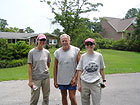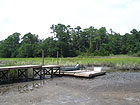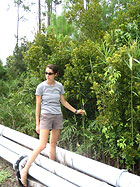

 | |||||||||||||||||
|
|
Journals 2006/2007Anna Hilton
August 9, 2006
Our next water and soil sampling trip took us to Whiskey Creek. We had permission to enter the creek at the residence of Minor Bishop. He and his wife not only allowed us to park at their home, but lent us their water hose to wash off the pluff mud after our trip. Minor brought us a stack of old towels to use to dry off before we left. He also gave us the history of Whiskey Creek. I am a social studies and a science teacher so I was fascinated by the story of how Whiskey Creek got its name. It involved kegs of whiskey falling off a barge in the creek much to the delight of the Native Americans who lived on the creek banks so long ago! Minor also told us of the changes he had observed in his own backyard salt water creek. His dock in the creek had once been much more creek than mud. The creek banks had filled up with marsh grasses and pluff mud over the last two decades.
Denise Sanger, a (PI) Principal Investigator of the project, joined Lisa, Travis, and me for the day's research. It was so interesting to talk about the project with her. She was the expert and had much information to share. Denise told us the name of the tall grass we had seen in Hewletts creek was Phragmites. It is a reed or large grass native to wetland sites. I asked Denise if Phragmites grew in wetlands with high salt levels or more brackish water.
I wanted to know if the cooler, fresher water, the suburban area of the creek, or the recent sewage leak there was the cause of our small seine sample at Hewletts. Denise warned against my inferences concerning the small biota samples in Hewletts creek. We talked about the difficulty interpreting the data of the Tidal Creeks Monitoring and Assessment Project. Scientists have to consider all of the properties of the creek and there are many variables.
After a debate between Travis and Denise about a correct soil sampling technique, I reminded Travis that Denise, after all, is the "PI" while he was only a peon. I am glad he laughed at the joke. We talked about the best way to travel through the pluff mud. Lisa had noticed the pluff mud in Hewletts washed out more quickly that the pluff mud at Village Creek.
|
||||||||||||||||




